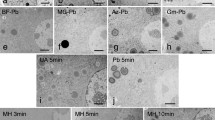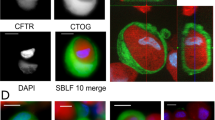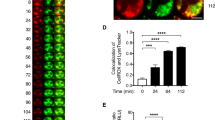Abstract
MAST cells are usually identified histochemically by the use of aldehyde fuchsin1, Hale2 or Rinehart3 stain, or by the metachromasia they exhibit with certain basic dyes. All these methods demonstrate mucopolysaccharides, although differences in the degree of staining of various mucopolysaccharides with the several methods have been noted4. Peracetic acid oxidation.(Greenspan's mixture 30 min., 25° C.)5 of tissue sections has been found to induce staining of certain normally unreactive substances with aldehyde fuchsin6–8, and to alter the susceptibility of oxytalan fibres to hyaluronidase, lysozyme and elastase7. During the course of investigations of mucopolysaccharide reactivity after peracetic acid oxidation, an interesting change was observed in mast-cell cytoplasms. Peracetic acid oxidation followed by digestion with enzymes which hydrolyse mucopolysaccharides resulted in diverse staining reactions with the above three methods for mucopolysaccharides.
This is a preview of subscription content, access via your institution
Access options
Subscribe to this journal
Receive 51 print issues and online access
$199.00 per year
only $3.90 per issue
Buy this article
- Purchase on Springer Link
- Instant access to full article PDF
Prices may be subject to local taxes which are calculated during checkout
Similar content being viewed by others
References
Gomori, G., Amer. J. Clin. Path., 20, 665 (1950).
Hale, C. W., Nature, 157, 802 (1946).
Rinehart, J. F., and Abul-Haj, S. K., Arch. Path., 52, 189 (1951).
Gomori, G., Brit. J. Exp. Path., 35, 377 (1954).
Lillie, R. D., “Histopathologic Technic and Practical Histochemistry”, 2nd edit. (Blakiston, New York, 1954.)
Fullmer, H. M., Science, 127, 1240 (1958).
Fullmer, H. M., and Lillie, R. D., J. Histochem. and Cytochem., 6, 425 (1958).
Fullmer, H. M., and Lillie, R. D., Proc. Histochem. Soc. (1958).
Meyer, K., Thompson, R., Palmer, J. W., and Khorazo, D., J. Biol. Chem., 113, 303 (1958).
Karunairatnam, M. C., Levy, G. A., Biochem. J., 43, 52 (1948).
Padawer, J., and Gordon, A. S., Anat. Rec., 121, 411 (1955).
Asboe-Hansen, G., and Glick, D., Proc. Soc. Exp. Biol. and Med., 98, 458 (1958).
Morris, A. L., and Krikos, G. A., Proc. Soc. Exp. Biol. and Med., 97, 527 (1958).
Author information
Authors and Affiliations
Rights and permissions
About this article
Cite this article
FULLMER, H. Differences in Mechanism in Staining Reactions for Mast Cells. Nature 183, 1274–1275 (1959). https://doi.org/10.1038/1831274a0
Issue Date:
DOI: https://doi.org/10.1038/1831274a0
This article is cited by
-
Mast Cell Mucopolysaccharides
Nature (1966)
-
Differences in Mechanism of Staining Reaction for Mast Cells of Some Lower Vertebrates
Nature (1961)
-
Der gegenw�rtige Stand der Mastzell-Forschung
Klinische Wochenschrift (1960)
Comments
By submitting a comment you agree to abide by our Terms and Community Guidelines. If you find something abusive or that does not comply with our terms or guidelines please flag it as inappropriate.



